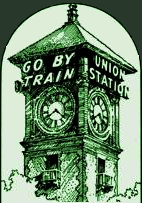
The Union Pacific Railroad In Oregon
A brief history by Glenn Laubaugh ; edited by Ron McCoy
The Union Pacific early presence in Oregon was under the names of the Oregon Short Line (OSL), Oregon Railway & Navigation Company (OR&N) and subsequently the Oregon-Washington Railroad & Navigation OWR&N) As time went on, these names fell into disuse. In later years of steam power, steam locomotives still carried the OWR&N company name, although the tenders of the locomotives usually had the Union Pacific name on them. All diesel locomotives came lettered and painted in Union Pacific colors, and therefore the Oregon-Washington Railroad & Navigation company name become much less visible as time went on, and the railroad appeared more as a subdivision of the Union Pacific's system than as a separate company.
From about 1968 until the late 1980's or early 1990's, the Union Pacific owned the Mt. Hood Railroad. This line was previously a short line, and after the UP ownership was sold back into shortline management. As of 1998, the operation continues, with a significant percentage of the revenue coming from passenger traffic.
In the 1960's through the 1980's, the vast majority of the branch lines from the main line into central Oregon were abandoned or sold off. The line along the Deschutes River to Bend and continuing south to a connection with the Southern Pacific main line at Chemult remained, however. Today, this line remains jointly operated between the Union Pacific and the BNSF.
A branch line from Brogan to Vale was abandoned in 1976. It appears to have been constructed in the late 1910's to early 1920's, but no references to its construction can be found in the literature.
There was some reorganization of the Union Pacific lines in Washington as a result of the abandonment of the Chicago, Milwaukee, St. Paul & Pacific in 1980.
In 1996, the Union Pacific railroad took over the operations of the Southern Pacific (SP) lines in Oregon, resulting in that railroad company becoming the largest railroad in the state (as well as the country). The railroad also gained direct access to many more of Oregon's populated cities in the Willamette Valley, while beforehand the only city on the Willamette River served by the UP was Portland. Although the UP had always been a vital link from Portland to the east, it didn't have this level of visibility before.
With the SP merger, UP inherited a large number of branch lines that had been leased to short lines, as well as the Willamette Valley and Willamette Pass main line to California. While UP still owns many of these lines, they do not appear on the UP map anymore.
By this time, most of the pre-merger Union Pacific branch line operations had also been sold or leased. As of 2001, a look at the Union Pacific map of Oregon shows short branch operating from Arlington south a few miles to to the community of Rock Creek, though a look at the tracks in-person shows them being used for storage of surplus freight cars. A branch from Castle (just west of Boardman) to the top of Poverty Ridge is also in operation, as is the branch from Rieth (just west of Pendleton) to Pilot Rock. A line from Hinkle northeast to the Washington state line is also operated as part of the UP's connection to Spokane.
An extensive number of short branch lines operate in and around Portland to serve various industries.
The central Oregon line from Celilo south to Bend and Chemult continues to be operated by the Union Pacific, as well as the Burlington Northern Santa Fe.
For more information, see:
- Early Oregon Days; Culp, Edwin D.; © 1987 by the author; The Caxton Printers, Ltd., 312 Main Street, Caldwell, Idaho 83605; ISBN 0-87004-314-5
- Union Pacific Northwest: The Oregon - Washington Railroad & Navigation Company; Asay, Jeff, © 1991 by Pacific Fast Mail, P.O. Box 57, Edmonds, Washington. ISBN 0-915713-21-7. Covers the entire history of most of the Union Pacific in Oregon, Washington and parts of Idaho.
- Encyclopedia of Western Railroad History, Volume III: Oregon, Washington; Robertson, Donald B., © 1995 by the author. Caxton Printers Ltd., Caldwell, Idaho 83605. ISBN (volume 3): 0-8700-4366-8. This is a general history of railroads in Oregon and Washington.
- Railroad Signatures Across the Pacific Northwest; Schwantes, Carlos A.; © 1993 by the University of Washington Press; Seattle and London. ISBN 0-295-97210-6.
- The History of the Northern Pacific Railroad © Louis Tuck Renz, published by Ye Galleon Press, Fairfield, Washington. ISBN 0-07770-235-7.
- The Train Watcher's Guide to North American Railroads; Drury, George H.; © 1984 Kalmbach Publishing Co. 21027 Crossroads Circle, Waukesha, WI 53187. Basic information, amount of rolling stock, rough maps, and history of railroads operating in North America.
Also visit our LINKS web page http://pnwc-nrhs.org/links.html


